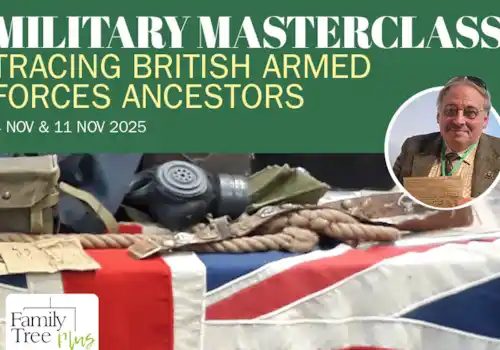04 October 2013
|
In November 2012 issue of Family Tree, we published a question from reader Les Pettit. This was then answered by Tim Lovering, wh
In November 2012 issue of Family Tree, we published a question from reader Les Pettit. This was then answered by Tim Lovering, who identified that the soldier was wearing a Warrant Officer’s uniform and cap badge of the Queens Own Dorset Yeomanry (with dark green band around the cap). Tim also believed it was taken pre the Great War. The quest to find out more about the soldier was then generously followed up by fellow reader Graham Caldwell. This led to the revelation of the previously unidentified soldier’s name and to Les and Graham meeting up in an Oxfordshire pub, despite living on opposite sides of the globe. Now, one year on, in our November 2013 issue we've covered Les's account of the remarkable discoveries they've made. Unfortunately there wasn't space in the magazine for everything, so we've pasted Graham's research steps below, because, as Les says, 'they are a model of clarity' and it's very useful to see how Graham gleaned clues from the tiniest leads - a good lesson to us all as genealogists:
- Captain Colin Parr (Rtd) the Curator of the Devon & Dorset Military Museum believes the picture was taken outside the entrance to the Blandford Drill Hall where “C” Squadron trained.
- The Warrant Officer’s rank badges on his lower sleeve are single large crowns and he’s wearing the officer’s pattern Sam Browne cross belt, plus the subject is short in stature. These three items are significant to eventually naming the soldier, as you'll see below.
- The Queens Own Dorset Yeomanry was originally a part-time Militia cavalry regiment until April 1908 when it was incorporated into the new Territorial-Force (TF) part-time reserve. The style of uniform is post TF making the picture no earlier than 1908.
- From 1902 until January 1915 the single crown rank badge was that of a Warrant Officer, whose rank was styled “Regimental Sergeant Major” (RSM). After war broke out the expansion of the Army called for two grades (or classes) of Warrant Officer, consequently Army Order 70 created a new grade called Warrant Officer Class 2 (ranked as Squadron Sergeant Major {SSM} in cavalry and Yeomanry regiments) who then wore the (downgraded) single large crown rank badge. From the same date all previous Warrant Officers were up-graded to Warrant Officer Class 1 ranked as RSMs and wore the newly introduced rank badge of the Royal Arms on their sleeves. It is therefore critical if the photograph was taken pre or post January 1915 to determine if the crown rank badge is the single RSM of the regiment or one of several SSMs from 1915 onwards.
- The Sam Browne belt is significant because only Warrant Officers (RSMs) pre January 1915 and Warrant Officer’s Class 1 (RSM’) post January 1915 were privileged to wear one. Because the rank badge in the picture is a single crown, this means that it was taken between 1908 and no later that December 1914 and the subject was the RSM of the Dorset Yeomanry during that time period.
- Colin Parr searched the nominal roll of the Dorset Yeomanry and I (Graham) provided confirmation that the RSM of the Dorset Yeomanry from 1st April 1903 until 15 November 1915 was James McElligott.
- James McElligott’s Army Pension File has survived and together with added genealogical research by Graham Caldwell it was established that James was baptised in Glasgow to parents of Irish ancestry as “John McElligott” on 4th January 1869, but changed his name to “James McElligott” upon enlistment to the 2nd Regiment of Dragoons, Royal Scots Greys, on 21st July 1886. This was because he was two years underage and lied about his age and parentage. It is significant that when aged 17½ his height was measured at 5ft. 8½ inches. After fighting in the Boar War James was posted as a SSM instructor to the Dorset Yeomanry on 5th February 1902. After serving for 11½ years as the RSM, James was commissioned a Quartermaster Lieutenant on 16th November 1914 and was later promoted Quartermaster Captain on 15th November 1917. After serving continuously for over 38 years James retired as a Hon. Captain on 9th September 1918.
- James McElligott was awarded two medals during his career (he never served overseas during World War I) which were the Queens South Africa Medal (with 5 campaign clasps) and the Long Service & Good Conduct Medal. But James is not wearing these as a medal ribbon bar in the picture. This might be explained because he’s wearing general service dress and not the full dress uniform of the regiment (aka “No 1’s) or it could be due to his modesty. This was evident in his 1911 census declaration were he simply stated his occupation as “Soldier” and in the column asking for ‘Occupation Description’ he simply put “Military Clerk & Accountant” (!). In any event any British Army Warrant Officer – even if never serving overseas – would by default have qualified for at least the LS&GC medal after 18 years service; consequently the lack of a medal ribbon bar is insignificant.
- The height of the soldier in the picture is estimated to acquaint to that of McElligott allowing for slight shrinkage since he was aged 17; being no less than 5ft. 6 inches and no more than 5ft. 8 inches.
- The age of McElligott in the picture cannot be over 45 years of age (i.e. born 1869 and the rank badge he’s wearing changed at the end of 1914) consequently his age is estimated at between 40 and 45, which means the picture was taken between 1909 and December 1914.
I have to say, I take my hat off to Graham - all this expertise, and done out of the goodness of his own heart too!








